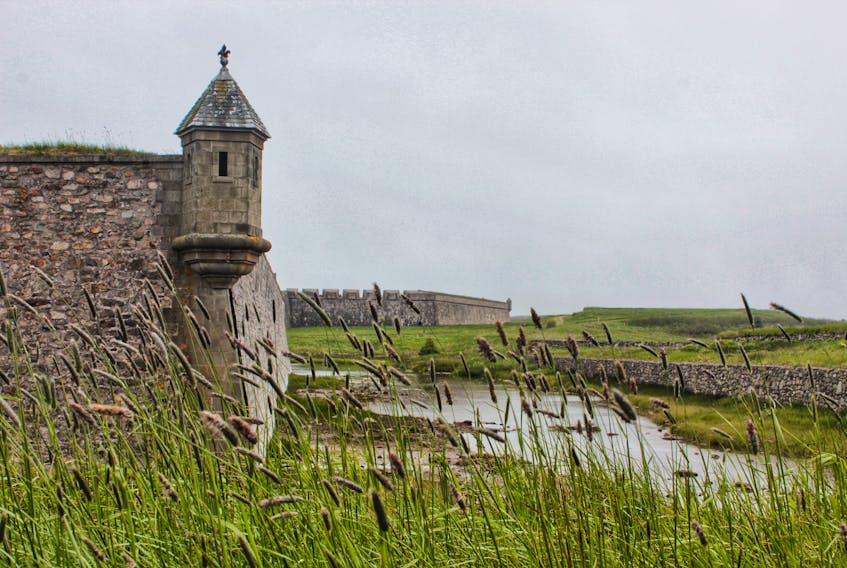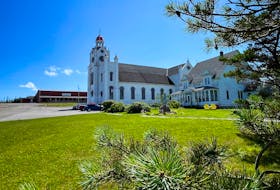As I step onto the red, wooden drawbridge over the little creek outside the Dauphin Gate, I can feel the presence of the 30 or so soldiers that once guarded this, the main entrance to the Fortress of Louisbourg on Cape Breton Island.
I pass beneath a stone arch carved with a coat of arms and through the heavy wooden doors to find a small bastion with six cannons, each weighing several tons. The iron cannonballs that flew from these heavy guns weighed 12 kilograms each.

Because the bastion could be attacked from both the land and the sea, troops stationed here paid a heavy price when the fortress was under siege. Fire from enemy ships in the harbour and from troops advancing on flat ground behind resulted in heavy casualties. Soldiers died on the grass where I’m standing as they defended the fortress, the town, and its residents.
I make my way into town to the residence of garrison officer Robert Duhaget. It’s open year-round and houses an exhibit called “Louisbourg as a fortress.” Upstairs, a film about Louisbourg entertains and educates visitors. Outside, there’s a tidy little kitchen garden.
Duhaget rose through the ranks here until illness forced him to return to France in 1757, where he soon died.
Imagination brings Louisbourg alive

Because Louisbourg is the only major colonial town without a modern city built on top of it, there’s something about this reconstructed site in this lonely place that seems closer to the past than most other living history museums. Especially in the low season, there are no modern noises or buildings to interfere with imagining the past, like the daily life of Duhaget.
Walking around the town in the off seasons, it almost seems like apparitions could appear through the mist in any doorway. The ghost of a French sailor, blacksmith or tavern keeper might greet you in the streets, which bustled with activity for decades in the 18th century.
Although it began as a fishing post in 1713, over 4,100 people lived here by the 1750s, just before it was abandoned after 1760. That’s four times the population of today’s Town of Louisbourg, located just outside the historic ramparts. Even though this is the largest reconstruction project on the continent, today’s Fortress Louisbourg is still only one-quarter the size it was at its peak.

The story of one of Fortress Louisbourg’s most fascinating characters is told in interpretive panels. Marie Marguerite Rose was captured in Africa and brought to Louisbourg at the age of 19. She spent 20 years as a slave in the Loppinot household before she was finally freed.
After her release, Rose married a Mi’kmaq man named Jean Baptiste Laurent. She ran an inn here until her death in 1757. Today, she’s named by the Government of Canada as a Person of National Historic Significance. Both the house where she worked as a slave and the building where she kept an inn are among those reconstructed.
Zooming out from the individual lives of those who found themselves in this French colonial outpost, it’s worth visiting a place that was at the centre of major world events. The fortress and town were built as one of France’s most important fortifications and named in honour of the flamboyant and extravagant King Louis XIV.
It played an important role in the ongoing struggles between France and Britain to gain a foothold on the North American continent. After the British captured Louisbourg in 1745, they traded it back to the French in exchange for territory in what is now Belgium. Although the fortress survived two sieges, the British recaptured the it in 1758 and intentionally destroyed it.
Changing of the Seasons

October is the month for a changing of the guard at the Fortress of Louisbourg when it shifts from shoulder season to low-season status. Like many of Nova Scotia’s national parks and national historic sites, Louisbourg is open year-round, even though in October, staff is tucking the fortress in for the winter.
Until Oct. 12, Louisbourg is open to the public seven days a week, 9:30 a.m. to 5 p.m. Visitors are free to explore the town and exhibits that remain open in several buildings. Brochures and a mobile app interpret the site, its many stories and its international significance.
Low season begins Oct. 13 and continues until May 23. Visiting hours are 9:30 a.m. to 4 p.m. on weekdays. The fortress is closed on weekends and statutory holidays.
During both shoulder and low seasons, an adult pass costs $7.40. There’s a seniors’ discount and youth under 18 get in free.
Because there are no services in the low season, many visitors opt to bring a picnic and spread it out on the ramparts with a view of the harbour, on the hill overlooking the town, or in a quiet backyard where livestock grazes in the summer months.
Photographers will find a photogenic place rich in atmosphere. History buffs and families will enjoy discovering and learning about one of North America’s most historically significant sites. Couples will find one of the most romantic locations anywhere. Outdoor adventurers can hike nearby coastal trails to the lighthouse and local beaches.
Perhaps the best reason to visit Fortress Louisbourg in the off seasons is to support the neighbouring modern town of Louisbourg. Travel by Nova Scotians and others inside the Atlantic bubble that supports Cape Breton and the town of Louisbourg when so many small businesses and communities are hurting from pandemic restrictions will echo one of the original purposes for the rebuilding of the fortress – in the 1960s and 1970s this major historical reconstruction employed out-of-work coal miners.
RESOURCES:
- https://www.pc.gc.ca/en/lhn-nhs/ns/louisbourg
- https://www.cbisland.com/businesses/?region=louisbourg-area













